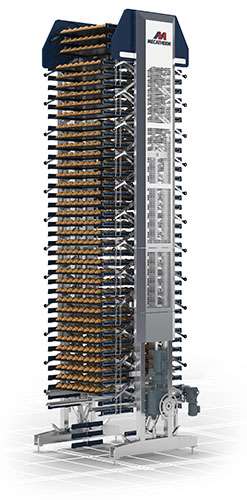
There are clear requirements for the proofing process. The dough may be resting, but its transformation process does nothing but rest. The question is, always, how to improve the process? Technology brings new answers.
One way to go is up
Another recent development in proofing technology is built around flexibility. Mecatherm’s M-UB Handling System supports all process stages and promises homogenous treatment of all products, on any type of support.
When proofing large volumes of dough, the stakes are higher in maintaining optimum conditions. All products must be exposed to the same airflow – at the required parameters. Measurements are taken continuously to regulate temperature and humidity rate according to settings defined by the baker. “The filtered, warmed and humidified air is blown in the proofer through textile blowing ducts positioned in the lower part of the enclosure. This air is then collected in one or more points of the upper part of the proofing enclosure. Air conditioning features and air flow circulation are calculated and adjusted following product rates, proofing parameters and enclosure volume and design, on a case-by-case basis to make sure that each product receives the same quantity of hot air,” explain Marie Laisne, Marketing Manager and François Retailleau, Product Manager, Lines and Digital solutions, from Mecatherm.
Several proofing systems handle products directly on belts. With vertical solutions, such as Mecatherm’s MVS and M-UB proofers, products are placed on proofing boards or pans.

Mecatherm’s vertical proofing provides several advantages, the two specialists detail:
- Easier maintenance
- Hygiene: the systems are very easy to clean
- Food safety: products are not in direct contact with the conveying system, limiting contamination risks
- No risk of dough damage/deformation (no transfers from one conveyor to another)
- Simple changeovers (flexibility for multi-product lines)
Proofing can be managed in two steps, which improves product quality control, by allowing different proofing temperatures in two different zones. “It is possible to have a warm zone first and a second, colder zone after. The second zone, the ‘retarder’, helps to provide better steam on the product, for a better volume and a better shine on the product surface, as well as a better development of aromas,” Mecatherm’s team explains.

Mecatherm’s MVS and M-UB modular proofers are designed to provide a high level of flexibility. The MVS proofer allows a wide range of capacities and dimensions, meaning it can operate with a wide variety of pans and peelboard sizes. They are also suitable for heavy-duty loads of up to 10 tons per module, Mecatherm highlights.
The M-UB proofer features a smooth top transfer system, with no shock, making it particularly adapted to the most sensitive products. It can also be flexibly used with a variety of products that have different proofing times: some modules can be easily bypassed to lower proofing time, when needed. Mecatherm adjusts proofing solutions as needed; for example, if products with different proofing times run simultaneously, a solution will be put in place to allow quick product transitions, which is a specialty of all Mecatherm proofers.
Innovations in every aspect of proofing help optimize the process and contribute towards the operation’s overall efficiency. End products with perfect color, texture and flavor are the result.
The article was originally published in Baking+Biscuit International magazine, issue 2 – 2023.


